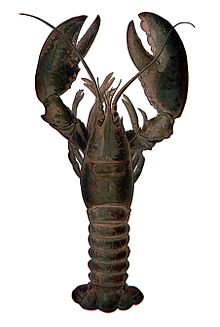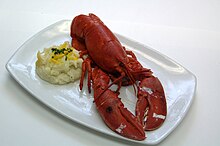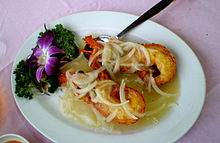Lobster
| Lobster Temporal range:
| |
|---|---|

| |
| American lobster, Homarus americanus | |
| Scientific classification | |
| Kingdom: | |
| Phylum: | |
| Subphylum: | |
| Class: | |
| Order: | |
| Suborder: | |
| Infraorder: | |
| Family: | Nephropidae Dana, 1852
|
| Genera [1] | |
| |
Clawed lobsters comprise a family (Nephropidae, sometimes also Homaridae) of large marine crustaceans. Highly prized as seafood, lobsters are economically important, and are often one of the most profitable commodities in coastal areas they populate.[2]
Though several groups of crustaceans are known as lobsters, the clawed lobsters are most often associated with the name. Clawed lobsters are not closely related to spiny lobsters or slipper lobsters, which have no claws (chelae), or squat lobsters. The closest relatives of clawed lobsters are the reef lobsters and the three families of freshwater crayfish.
Evolution
The fossil record of clawed lobsters extends back at least to the Valanginian Age of the Cretaceous.[3]
Description
Lobsters are invertebrates with a hard protective exoskeleton. Like most arthropods, lobsters must molt in order to grow, which leaves them vulnerable. During the molting process, several species change color. Lobsters have 10 walking legs; the front three pairs bear claws, the first of which are larger than the others.[4] Although, like most other arthropods, lobsters are largely bilaterally symmetrical, they often possess unequal, specialized claws, like the king crab.
Lobster anatomy includes the cephalothorax which fuses the head and the thorax, both of which are covered by a chitinous carapace, and the abdomen. The lobster's head bears antennae, antennules, mandibles, the first and second maxillae, and the first, second, and third maxillipeds. Because lobsters live in a murky environment at the bottom of the ocean, they mostly use their antennae as sensors. The lobster eye has a reflective structure above a convex retina. In contrast, most complex eyes use refractive ray concentrators (lenses) and a concave retina.[5] The abdomen includes swimmerets and its tail is composed of uropods and the telson.
Lobsters, like snails and spiders, have blue blood due to the presence of haemocyanin which contains copper[6] (in contrast, vertebrates and many other animals have red blood from iron-rich haemoglobin). Lobsters possess a green hepatopancreas, called the tomalley by chefs, which functions as the animal's liver and pancreas.[7]
In general, lobsters are 25–50 centimetres (10–20 in)* long, and move by slowly walking on the sea floor. However, when they flee, they swim backwards quickly by curling and uncurling their abdomen. A speed of 5 metres per second (11 mph) has been recorded.[8] This is known as the caridoid escape reaction.
Longevity
Recent research suggests that lobsters may not slow down, weaken, or lose fertility with age. In fact, older lobsters are more fertile than younger lobsters. This longevity may be due to telomerase, an enzyme that repairs DNA sequences of the form "TTAGGG."[9] This sequence, repeated hundreds of times, occurs at the ends of chromosomes, which are referred to as the telomeres.[10][11] It has been argued that lobsters may exhibit negligible senescence and some scientists have claimed that they could effectively live indefinitely, barring injury, disease, capture, etc.[12] Their longevity allows them to reach impressive sizes. According to the Guinness World Records, the largest lobster was caught in Nova Scotia, Canada, and weighed 20.15 kilograms (44.4 lb).[13][14]
Symbion
Animals of the genus Symbion, the only member of the animal phylum Cycliophora, live exclusively on lobster gills and mouthparts.[15]
Ecology
Lobsters are found in all oceans. They live on rocky, sandy, or muddy bottoms from the shoreline to beyond the edge of the continental shelf. They generally live singly in crevices or in burrows under rocks.
Lobsters are omnivores and typically eat live prey such as fish, mollusks, other crustaceans, worms, and some plant life. They scavenge if necessary, and may resort to cannibalism in captivity; however, this has not been observed in the wild. Although lobster skin has been found in lobster stomachs, this is because lobsters eat their shed skin after molting.[16]
Gastronomy
| Nutritional value per 100 g (3.5 oz) | |
|---|---|
| Energy | 410 kJ (98 kcal) |
0 g | |
| Sugars | 0 g |
| Dietary fibre | 0 g |
0.59 g | |
| Saturated | 0.107 g |
| Monounsaturated | 0.091 g |
| Polyunsaturated | 0.16 g |
20.5 g | |
| Vitamins | Quantity %DV† |
| Thiamine (B1) | 0% 0 mg |
| Riboflavin (B2) | 308% 4 mg |
| Niacin (B3) | 25% 4 mg |
| Pantothenic acid (B5) | 40% 2 mg |
| Vitamin B6 | 235% 4 mg |
| Folate (B9) | 1% 2 μg |
| Vitamin C | 0% 0 mg |
| Minerals | Quantity %DV† |
| Calcium | 0% 6 mg |
| Iron | 11% 2 mg |
| Magnesium | 2% 8 mg |
| Phosphorus | 1% 15 mg |
| Potassium | 0% 0 mg |
| Zinc | 136% 15 mg |
| †Percentages estimated using US recommendations for adults,[17] except for potassium, which is estimated based on expert recommendation from the National Academies.[18] | |


Lobster recipes include Lobster Newberg and Lobster Thermidor. Lobster is used in soup, bisque, lobster rolls, and cappon magro. Lobster meat may be dipped in clarified butter, resulting in a sweetened flavour.
Cooks boil or steam live lobsters. The lobster cooks for seven minutes for the first pound and three minutes for each additional pound.[19]
According to the United States Food and Drug Administration (FDA), the mean level of mercury in American lobster is 0.31 ppm.[20]
History
In North America, the American lobster did not achieve popularity until the mid-19th century, when New Yorkers and Bostonians developed a taste for it, and commercial lobster fisheries only flourished after the development of the lobster smack.[21] Prior to this time, lobster was considered a mark of poverty or as a food for indentured servants or lower members of society in Maine, Massachusetts and the Canadian Maritimes, and servants specified in employment agreements that they would not eat lobster more than twice per week.[22] American lobster was initially deemed worthy only of being used as fertilizer or fish bait, and it was not until well into the twentieth century that it was viewed as more than a low-priced canned staple food.[23]
Caught lobsters are graded as new-shell, hard-shell and old-shell and, because lobsters that have recently shed their shells are the most delicate, there is an inverse relationship between the price of American lobster and its flavor. New-shell lobsters have paper-thin shells and a worse meat-to-shell ratio, but what meat exists is very sweet. However, the lobsters are so delicate that even transport to Boston almost kills them, making the market for new-shell lobsters strictly local to the fishing towns where they are offloaded. Hard-shell lobsters with firm shells but with less sweet meat can survive shipping to Boston, New York and even Los Angeles so they command a higher price than new-shell lobsters. Meanwhile, old-shell lobsters, which have not shed since the previous season and have a coarser flavor, can be air-shipped anywhere in the world and arrive alive, making them the most expensive. One seafood guide notes that an eight dollar lobster dinner at a restaurant overlooking fishing piers in Maine is consistently delicious, while "the eighty-dollar lobster in a three-star Paris restaurant is apt to be as much about presentation as flavor".[23]
Animal welfare issues
The most common way of killing a lobster is by placing it live in boiling water (with or without spending a period of time in a freezer) or by splitting it by severing the body in half lengthwise. Lobsters may also be killed or rendered insensate immediately before boiling through a stab into the brain, in the belief that this will stop suffering. However, a lobster's brain operates from not one but several ganglia and disabling only the frontal ganglion does not usually result in death or unconsciousness.[11] The boiling method is illegal in some places, such as in Reggio Emilia, Italy, where offenders face fines of up to €495.[24]
Fishery and aquaculture
Lobsters are caught using baited, one-way traps with a color-coded marker buoy to mark cages. Lobster is fished in water between 1 and 500 fathoms (2 and 900 m), although some lobsters live at 2,000 fathoms (3,700 m). Cages are of plastic-coated galvanized steel or wood. A lobster fisher may tend as many as 2,000 traps. Around the year 2000, due to overfishing and high demand, lobster aquaculture expanded.[25] As of 2008, no lobster aquaculture operation had achieved commercial success, due mainly to the fact that lobsters eat each other (cannibalism) and the slow growth of the species; these two problems make it difficult to make lobster aquaculture profitable.[26] The New England Aquarium nonetheless maintains a year-round production facility of American lobster, and further research is being conducted.[27]
Species
This list contains all extant species in the family Nephropidae:[28]
- Acanthacaris caeca A. Milne-Edwards, 1881
- Acanthacaris tenuimana Bate, 1888
- Dinochelus Ahyong, Chan & Bouchet, 2010
- Dinochelus ausubeli Ahyong, Chan & Bouchet, 2010
- Eunephrops Smith, 1885
- Eunephrops bairdii Smith, 1885
- Eunephrops cadenasi Chace, 1939
- Eunephrops luckhursti Manning, 1997
- Eunephrops manningi Holthuis, 1974
- Homarinus Kornfield, Williams & Steneck, 1995
- Homarinus capensis (Herbst, 1792) – Cape lobster
- Homarus Weber, 1795
- Homarus americanus H. Milne-Edwards, 1837 – American lobster
- Homarus gammarus (Linnaeus, 1758) – European lobster
- Metanephrops Jenkins, 1972
- Metanephrops andamanicus (Wood-Mason, 1892) – Andaman lobster
- Metanephrops arafurensis (De Man, 1905)
- Metanephrops armatus Chan & Yu, 1991
- Metanephrops australiensis (Bruce, 1966) – Australian scampi
- Metanephrops binghami (Boone, 1927) – Caribbean lobster
- Metanephrops boschmai (Holthuis, 1964) – bight lobster
- Metanephrops challengeri (Balss, 1914) – New Zealand scampi
- Metanephrops formosanus Chan & Yu, 1987
- Metanephrops japonicus (Tapparone-Canefri, 1873) – Japanese lobster
- Metanephrops mozambicus Macpherson, 1990
- Metanephrops neptunus (Bruce, 1965)
- Metanephrops rubellus (Moreira, 1903)
- Metanephrops sagamiensis (Parisi, 1917)
- Metanephrops sibogae (De Man, 1916)
- Metanephrops sinensis (Bruce, 1966) – China lobster
- Metanephrops taiwanicus (Hu, 1983)
- Metanephrops thomsoni (Bate, 1888)
- Metanephrops velutinus Chan & Yu, 1991
- Nephropides Manning, 1969
- Nephropides caribaeus Manning, 1969
- Nephrops Leach, 1814
- Nephrops norvegicus (Linnaeus, 1758) – Norway lobster, Dublin Bay prawn, langoustine
- Nephropsis Wood-Mason, 1872
- Nephropsis acanthura Macpherson, 1990
- Nephropsis aculeata Smith, 1881 – Florida lobsterette
- Nephropsis agassizii A. Milne-Edwards, 1880
- Nephropsis atlantica Norman, 1882
- Nephropsis carpenteri Wood-Mason, 1885
- Nephropsis ensirostris Alcock, 1901
- Nephropsis holthuisii Macpherson, 1993
- Nephropsis malhaensis Borradaile, 1910
- Nephropsis neglecta Holthuis, 1974
- Nephropsis occidentalis Faxon, 1893
- Nephropsis rosea Bate, 1888
- Nephropsis serrata Macpherson, 1993
- Nephropsis stewarti Wood-Mason, 1872
- Nephropsis suhmi Bate, 1888
- Nephropsis sulcata Macpherson, 1990
- Thaumastocheles Wood-Mason, 1874
- Thaumastocheles dochmiodon Chan & Saint Laurent, 1999
- Thaumastocheles japonicus Calman, 1913
- Thaumastocheles zaleucus (Thomson, 1873)
- Thaumastochelopsis Bruce, 1988
- Thaumastochelopsis brucei Ahyong, Chu & Chan, 2007
- Thaumastochelopsis wardi Bruce, 1988
- Thymopides Burukovsky & Averin, 1977
- Thymopides grobovi (Burukovsky & Averin, 1976)
- Thymopides laurentae Segonzac & Macpherson, 2003
- Thymops Holthuis, 1974
- Thymops birsteini (Zarenkov & Semenov, 1972)
- Thymopsis Holthuis, 1974
- Thymopsis nilenta Holthuis, 1974
References
- ^ Sammy De Grave, N. Dean Pentcheff, Shane T. Ahyong; et al. (2009). "A classification of living and fossil genera of decapod crustaceans" (PDF). Raffles Bulletin of Zoology. Suppl. 21: 1–109.
{{cite journal}}: Explicit use of et al. in:|author=(help)CS1 maint: multiple names: authors list (link) - ^ "Homarus americanus, American lobster" (PDF). McGill University. 27 June 2007.
- ^ Dale Tshudy, W. Steven Donaldson, Christopher Collom, Rodney M. Feldmann & Carrie E. Schweitzer (2005). "Hoploparia albertaensis, a new species of clawed lobster (Nephropidae) from the Late Coniacean, shallow-marine Bad Heart Formation of northwestern Alberta, Canada". Journal of Paleontology. 79 (5): 961–968. doi:10.1666/0022-3360(2005)079[0961:HAANSO]2.0.CO;2.
{{cite journal}}: CS1 maint: multiple names: authors list (link) - ^ Carlos Robles (2007). "Lobsters". In Mark W. Denny & Steven Dean Gaines (ed.). Encyclopedia of tidepools and rocky shores. University of California Press. pp. 333–335. ISBN 978-0-520-25118-2.
- ^ M. F. Land (1976). "Superposition images are formed by reflection in the eyes of some oceanic decapod Crustacea". Nature. 263 (5580): 764–765. doi:10.1038/263764a0. PMID 995187.
- ^ "Copper for life – Vital copper". Association for Science Education.
- ^ Shona Mcsheehy & Zoltán Mester (2004). "Arsenic speciation in marine certified reference materials". Journal of Analytical Atomic Spectrometry. 19 (3): 373–380. doi:10.1039/b314101b.
- ^ "The American lobster – frequently asked questions". St. Lawrence Observatory, Fisheries and Oceans Canada. October 19, 2005.
- ^ John W. Kimball (November 25, 2008). "Telomeres".
- ^ Jacob Silverman. "Is there a 400 pound lobster out there?". howstuffworks.
- ^ a b David Foster Wallace (2005). "Consider the Lobster". Consider the Lobster and Other Essays. Little, Brown & Company. ISBN 0-316-15611-6.
{{cite book}}: External link in|chapterurl=|chapterurl=ignored (|chapter-url=suggested) (help) - ^ John C. Guerin (2006). "Emerging area of aging research: long-lived animals with "negligible senescence"". Annals of the New York Academy of Sciences. 1019 (1): 518–520. doi:10.1196/annals.1297.096. PMID 15247078.
- ^ "Heaviest marine crustacean". Guinness World Records. Archived from the original on May 28, 2006. Retrieved August 3, 2006.
- ^ "Giant lobster landed by boy, 16". BBC News. June 26, 2006.
- ^ M. Obst, P. Funch & G. Giribet (2005). "Hidden diversity and host specificity in cycliophorans: a phylogeographic analysis along the North Atlantic and Mediterranean Sea". Molecular Ecology. 14 (14): 4427–4440. doi:10.1111/j.1365-294X.2005.02752.x. PMID 16313603.
- ^ "Homarus americanus, Atlantic lobster". MarineBio.org. Retrieved December 27, 2006.
- ^ United States Food and Drug Administration (2024). "Daily Value on the Nutrition and Supplement Facts Labels". Retrieved 2024-03-28.
- ^ National Academies of Sciences, Engineering, and Medicine; Health and Medicine Division; Food and Nutrition Board; Committee to Review the Dietary Reference Intakes for Sodium and Potassium (2019). Oria, Maria; Harrison, Meghan; Stallings, Virginia A. (eds.). Dietary Reference Intakes for Sodium and Potassium. The National Academies Collection: Reports funded by National Institutes of Health. Washington, DC: National Academies Press (US). ISBN 978-0-309-48834-1. PMID 30844154.
- ^ "Cooking lobsters". Atwood Lobster Company. Archived from the original on June 7, 2007. Retrieved June 30, 2007.
- ^ "Mercury Levels in Commercial Fish and Shellfish". Food and Drug Administration. Retrieved December 25, 2009.
- ^ Colin Woodard (2004). The Lobster Coast. New York: Viking/Penguin. pp. 170–180. ISBN 0-670-03324-3.
- ^ Henderson, Mark (October 24, 2005). "How lobster went up in the world". London: The Times. Retrieved May 11, 2010.
- ^ a b Johnson, Paul (2007). "Lobster". Fish Forever: The Definitive Guide to Understanding, Selecting, and Preparing Healthy, Delicious, and Environmentally Sustainable Seafood. John Wiley & Sons. pp. 163–175. ISBN 978-0-7645-8779-5.
- ^ Bruce Johnston (March 6, 2004). "Italian animal rights law puts lobster off the menu". London: Daily Telegraph.
- ^ Asbjørn Drengstig, Tormod Drengstig & Tore S. Kristiansen. "Recent development on lobster farming in Norway – prospects and possibilities". UWPhoto ANS.
- ^ Problems surrounding lobster aquaculture
- ^ Lobster lab
- ^ Tin-Yam Chan (2010). Martyn E. Y. Low and S. H. Tan (ed.). "Annotated checklist of anomuran decapod crustaceans of the world (exclusive of the Kiwaoidea and families Chirostylidae and Galatheidae of the Galatheoidea) and marine lobsters of the world" (PDF). Zootaxa. Suppl. 23: 153–181.
{{cite journal}}:|chapter=ignored (help)







